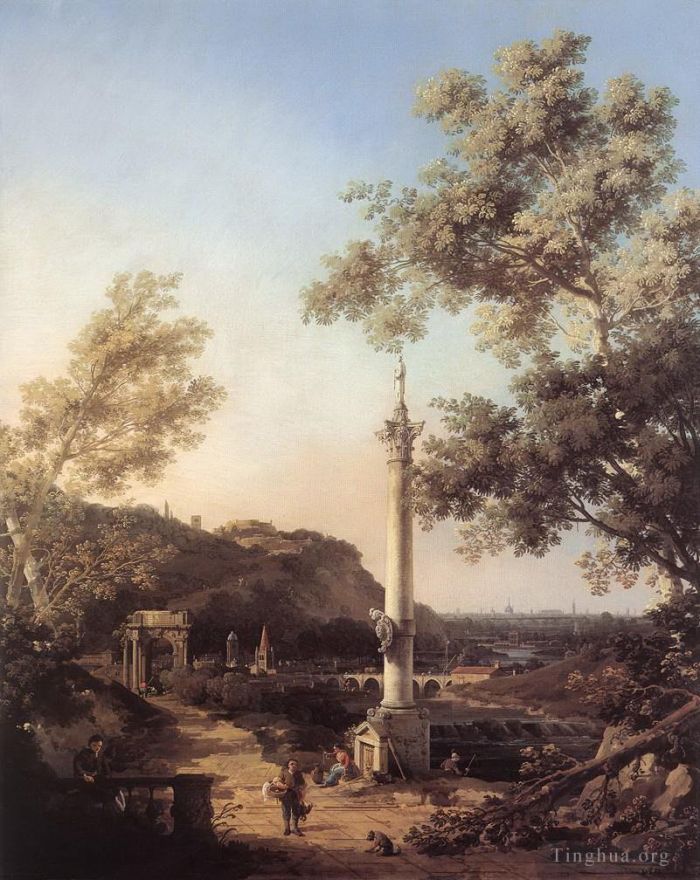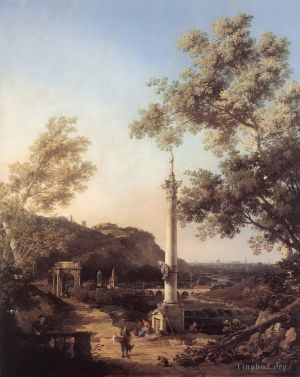English Landscape Capriccio with a Column
Canaletto
- Price: Price on Request
- Art Type: Oil Painting
- Size:
- English Comments: 0
- International Comments: 0
- Creating Date:
- Introduction and Works of Canaletto >>
Work Overview
- English Landscape Capriccio with a Column
Canaletto
Date: c.1754
Style: Rococo
Genre: capriccio
oil on canvas
134 x 106.4 cm (52 3/4 x 41 7/8 in.)
This is another fine example of the type of capricci Canaletto executed during his sojourn in England. It is one of a group of paintings known as the 'Lovelace Canalettos', so-called because they were sold in 1937 by the Earl of Lovelace. He had inherited them from Lord King who probably acquired them in the eighteenth century for his home, Ockham Place in Surrey.
This work is an ingenious combination of Italian and English influences - a fitting project for Canaletto to work on prior to his final return to Venice, after having spent nearly a decade in England. The general disposition of the hilly landscape and the vegetation appear English, and a bridge inspired by Westminster Bridge has been placed in the middle distance. The Corinthian column, however, decorated with an escutcheon and surmounted by a statue of a saint, and the triumphal arch, are clearly Italianate. The juxtaposition of these two sets of references cleverly and subtly encourages you to question what is real, and what is imagined.
The support is a plain-weave, medium-weight fabric. The thread count differs slightly from the support of the pendant (1964.2.2) and confirms that different rolls of fabric were used for each. A thin white ground is visible at the edges of the paint surface. The paint was applied wet-over-dry with only a few small passages painted wet-in-wet. The composition was built up from the middle ground, with each compositional detail completed before the addition of subsequent pictorial elements above. The column as well as the figures were painted over the fully developed landscape. The figures were sketched quickly with a dark wash that was allowed to dry before color was added over it using a thicker, opaque paint, with a lighter hue for the highlighted areas and a darker tone of the same color for the shadows. The highlights were applied more thickly. Some red pigment was added to create a warmer tonality in the sky. X-radiographs reveal successive minor changes to the gabled top of the small architectural element at the base of the column.
The tacking margins have been removed, but cusping along the vertical edges suggests that the painting retains its original dimensions. Small losses are located in the upper-left corner, and slight abrasion is evident in the thinly painted areas of the distant landscape. The varnish is slightly yellowed. The painting, which was lined at an unknown date, has not been treated since acquisition.
- Copyright Statement:
All the reproduction of any forms about this work unauthorized by Singing Palette including images, texts and so on will be deemed to be violating the Copyright Laws.
To cite this webpage, please link back here.
- >> English Comments
- >> Chinese Comments
- >> French Comments
- >> German Comments
- >>Report
- Capriccio with ruins and porta portello in padua
- The women s regaton the grand canal
- The campo di rialto
- The Eastern Facade Of Warwick Castle
- Riva degli Schiavoni west side
- The piazzetta towards san giorgio maggiore
- Doge Palace
- Santa Maria Zobenigo
- Grand Canal
- San Giacomo Di Rialto
- The Piazzetta
- Capriccio with classical ruins and buildings
- Grand Canal From Santa Maria Della Carita To The Bacino Di San Marco
- Basilica di vecenza and the ponte de rialto
- Capriccio of a round church with an elaborate gothic portico in a piazza a palladian piazza and 1755
- Piazza San Marco Venice (Piazza San Marco with the Basilica)
- The Nave of San Marco looking East (San Marco the Interior)
- Warwick castle
- The Bucintoro Returning To The Molo On Ascension Day
- A Regatta on the Grand Canal
- Venice Viewed from the San Giorgio Maggiore
- View of the Ducal Palace
- Piazza san marco looking east
- The Bacino di San Marco on Ascension Day
- View Of the Entrance To The Arsenal
- Dolo On The Brenta Venetian Venice
- The Molo Looking West
- Palazzo Ducale and the Piazza di San Marco
- Grand Canal The Rialto Bridge From The South
- Scala dei giganti 1765
- The Riva Degli Schiavoni
- Rio Dei Mendicanti
- The interior of henry vii chapel in westminster abbey
- View of the grand walk vauxhall gardens with the orchestra pavilion the organ house the turkish
- Perspective View with Portico
- Stonemasons Yard
- View of the Bacino di San Marco St Marks Basin
- Perspective with a portico 1765
- The thames with st pauls cathedral 1746
- Piazza San Marco 1730
- Reception Of The Ambassador In The Doges Palace
- Dolo on the brenta
- Return Of The Bucentoro To The Molo On Ascension Day
- The chapel of eton college 1747
- The Grand Canal From Rialto Toward The North
- The Grand Canal with the Rialto Bridge in the Background
- View Of Campo Santi Apostoli
- Perspective view with portico
- Capriccio of the grand canal with an imaginary rialto bridge and other buildings
- London Interior of the Rotunda at Ranelagh
- The Grand Canal looking East from Campo San Vio towards the Bacino
- The Fonteghetto Della Farina
- The Piazzetta towards S. Giorgio Maggiore
- The thames and the city of london from richmond house 1746
- Campo san rocco
- Night time celebration outside the church of san pietro di castello
- The Stonemasons Yard
- Canal Giovanni Antonio View Of The Grand Canal And Santa Maria Della Salute With Boats And Figure
- The Piazzetta towards Santa Maria della Salute
- Piazza San Marco The Clocktower
- Capriccio of a renaissance triumphal arch seen from the portico of a palace 1755
- Bacino di San Marco St Marks Basin
- San francesco della vigna church and campo
- Entrance To The Grand Canal Looking East
- Alnwick castle
- Piazza San Marco Looking Southeast
- Westminster abbey with a procession of knights of the bath 1749
- CANALETTO Grand Canal Looking Northeast From Palazo Balbi Toward The Rial to Bridge
- The Feast Day of St Roch
- Arrival of the French Ambassador in Venice
- CANALETTO Grand Canal Looking East From The Campo San Vio
- Capriccio Ruins And Classic Buildings
- The Entrance to the Grand Canal Venice
- A Regatta on the Grand Canal
- English Landscape Capriccio with a Column
- The dogana in Venice (Punta della Dogana in Venice)
- Santi Giovanni E Paolo And The Scuola Di San Marco 1726
- Campo santa maria formosa
- The Piazza San Marco in Venice
- San Cristoforo San Michele and Murano from the Fondamenta Nuove Venice
- The Grand Canal with Santa Maria della Salute looking East towards the Bacino
- Rome the arch of constantine 1742
- Santi Giovanni e Paolo and the Scuola de San Marco
- The Grand Canal near the Ponte di Rialto
- Venice Piazza San Marco and the Colonnade of the Procuratie Nuove









 Singing Palette
Singing Palette